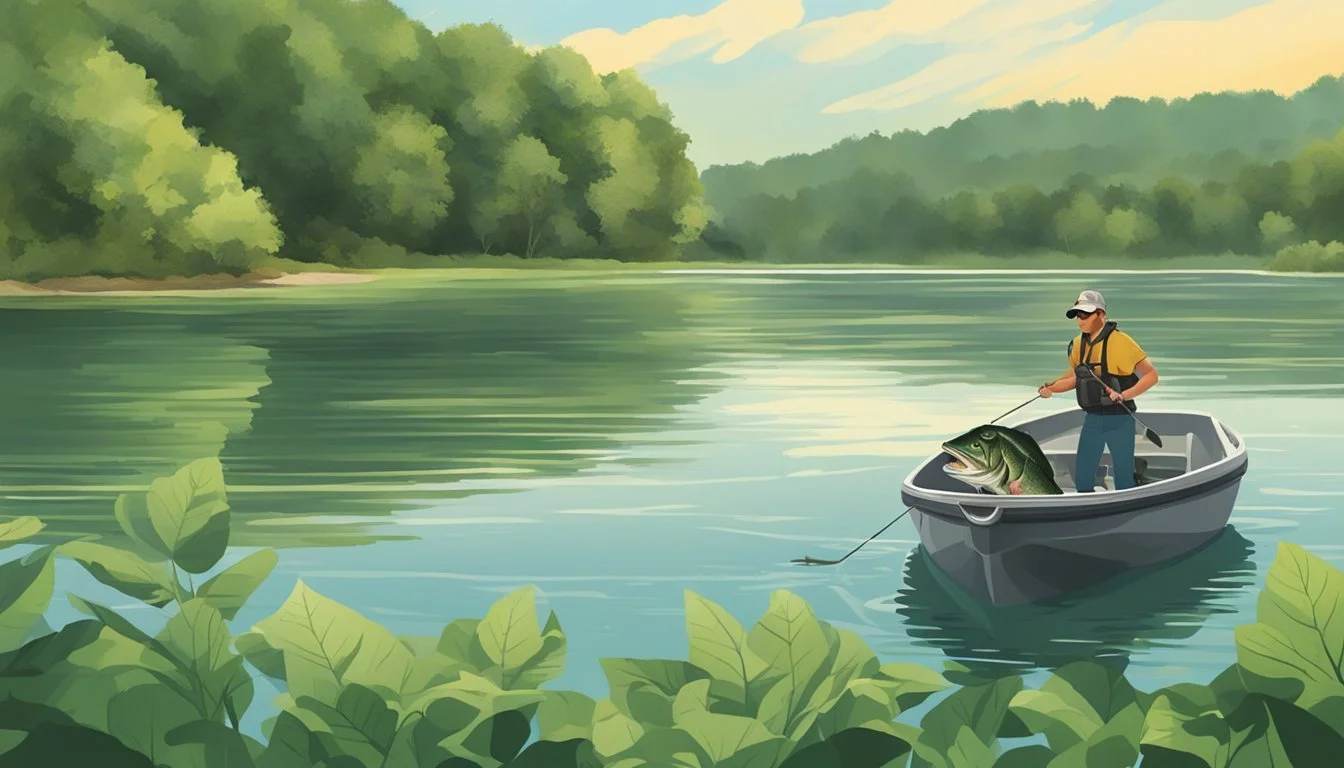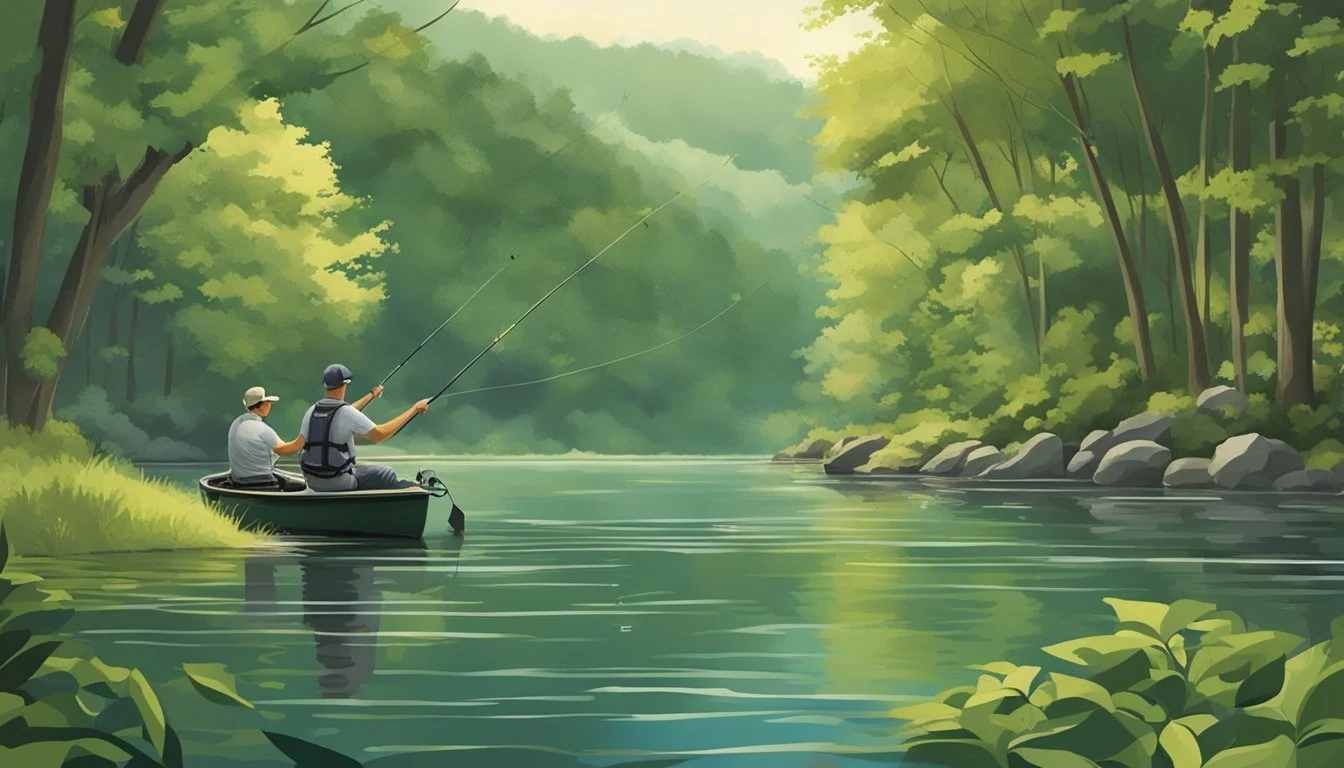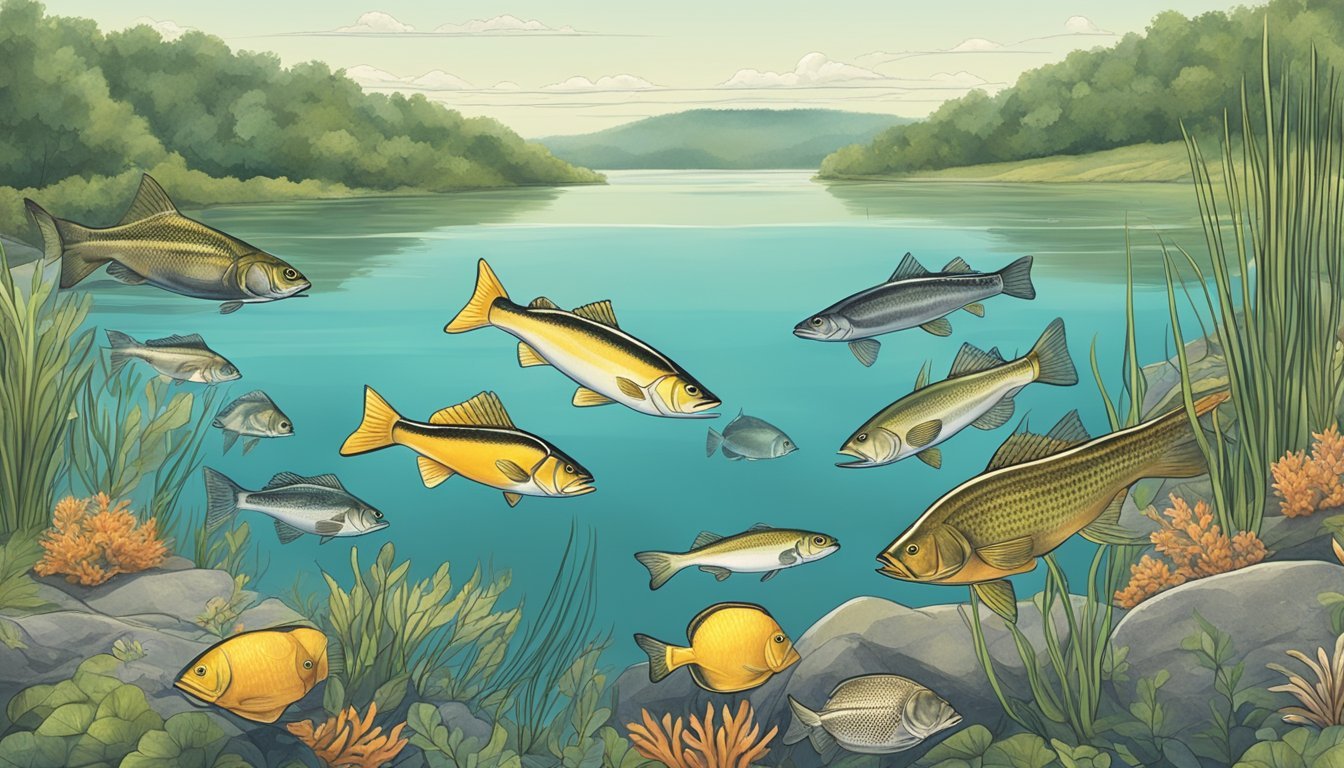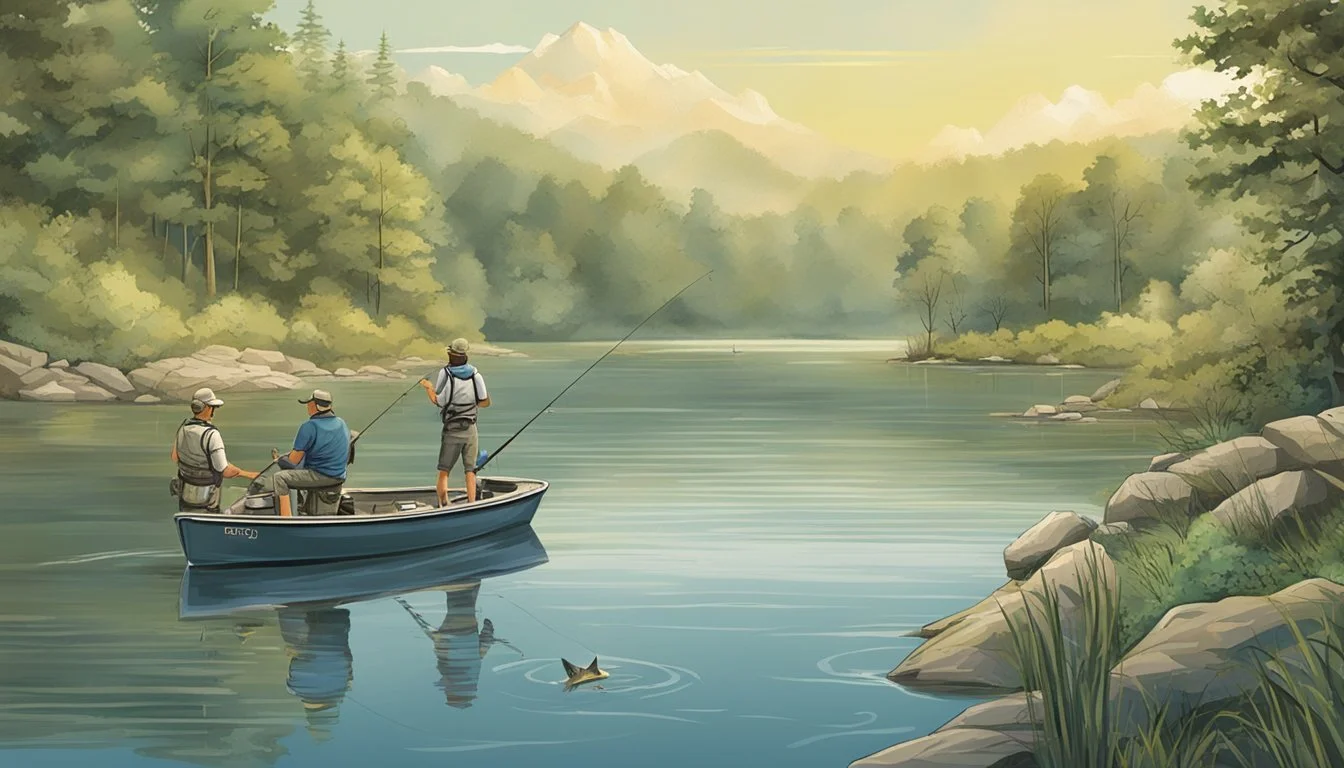Best Fish to Catch and Eat in Kentucky
A Local Angler's Guide
Kentucky offers a rich tapestry of freshwater fishing opportunities, with its numerous lakes and streams home to a variety of fish (What wine goes well with fish?) species that are not only exhilarating to catch but also delicious to eat. Anglers in the Bluegrass State can expect to reel in species like the sought-after Walleye in Lake Cumberland, known for their tender, flaky meat that makes an excellent meal when grilled or fried. Walleye thrive as night hunters, so fishing after dark can yield a fruitful catch, especially during the spring spawning season when they congregate in shallower areas.
Bass fishing also ranks high among the best piscatorial pursuits in Kentucky, with the state record largemouth being caught from Highsplint Lake. The diverse ecosystems in Kentucky lakes, such as Kentucky Lake, Lake Barkley, and Dale Hollow Reservoir, support both smallmouth and largemouth bass, providing anglers with ample opportunities to land a few of these popular game fish known for their robust flavor and firm texture.
Other notable catches in Kentucky waters include the muskie, a true trophy fish, which avid fishermen can encounter in places like Cave Run Lake, alongside other species such as crappie and white bass. Each of these species offers its own unique flavors and culinary experiences, enhancing Kentucky's reputation as a destination not only for sport but also for those who take pleasure in harvesting and savoring their catch.
Popular Fish Species in Kentucky
Kentucky waters offer a diverse range of fish species, attracting anglers for both sport fishing and culinary delights. From the fighting bass to the sought-after catfish, these waters promise rewarding catches.
Largemouth and Smallmouth Bass
In Kentucky, largemouth bass thrive in warmer, vegetated lake areas, while smallmouth bass prefer cooler, flowing streams. Both species are popular for their spirited fight and are widely targeted during competitive fishing events.
Catfish Varieties
Catfish in Kentucky are abundant with several species such as channel, blue, and flathead catfish. The blue catfish, known for its impressive size, can weigh over 100 pounds, providing both a challenging catch and a substantial meal.
Crappie Seasonal Availability
Black and white crappie are plentiful in Kentucky's lakes and reservoirs. Best caught in spring, when they spawn in shallow water, crappies are a favorite for their flaky, white flesh, perfect for pan-frying or baking.
Walleye and Sauger Habitats
The cool, deep waters of Kentucky's lakes are home to walleye and sauger. These well-camouflaged fish are more commonly caught during dawn or dusk. Their fine-textured meat makes them particularly popular with anglers who love to cook their catch.
Trout Hotspots
Trout enthusiasts will find rainbow, brown, and brook trout in Kentucky's colder streams. The Cumberland River is a notable hotspot, offering anglites the chance to catch trout that are both challenging to land and excellent in taste.
Muskie in Kentucky Waters
Kentucky offers robust muskie fishing opportunities, particularly in Cave Run Lake and Green River Lake. Known as the "fish of ten thousand casts," muskies are a trophy fish that require patience and persistence to catch.
Kentucky's Prime Fishing Locations
Kentucky boasts a diverse range of fishing spots, each offering a unique set of species for anglers to target and culinary delights to enjoy back home. From vast lakes to winding rivers, Kentucky presents premier fishing opportunities for everyone from the casual fisher to the seasoned angler.
Renowned Lakes and Reservoirs
Lake Cumberland: Recognized for its deep, clear waters and abundance of striped bass.
Kentucky Lake & Lake Barkley: Together forming one of the largest artificial bodies of water in the United States, these lakes are famous for crappie, largemouth bass, and catfish.
Green River Lake: A must-visit destination for muskie fishing in central Kentucky, also stocked with largemouth bass and crappie.
Dale Hollow Lake: Near the border with Tennessee and known for record-breaking smallmouth bass.
Cave Run Lake & Laurel River Lake: Located in eastern Kentucky, these lakes offer excellent largemouth and spotted bass fishing.
Paintsville Lake: A smaller lake in comparison, but offers a variety of species including bass, crappie, and bluegill.
River Fishing Opportunities
Cumberland River: Renowned for its trout fishing, below the Wolf Creek Dam resides one of the best tailwaters in the state.
Green River: Offers some of the finest smallmouth bass fishing in Kentucky, as well as abundant catfish, walleye, and sauger.
Ohio River: A large river system that presents opportunities for diverse fishing experiences, targeting species such as bass, catfish, and sauger.
Notable Tailwaters
Below Lake Cumberland: The Cumberland River's tailwaters are home to a thriving population of rainbow and brown trout.
Below Barkley Dam: Tailwaters here provide anglers with year-round fishing, especially for striped bass and hybrids.
Creeks and Smaller Streams
In central Kentucky: Elkhorn Creek is popular for smallmouth bass.
Throughout the state: Smaller water bodies, such as Tygarts Creek and Hickman Creek, offer secluded spots teeming with bass and panfish.
Essential Fishing Techniques
Mastering a variety of fishing techniques enhances an angler's adaptability to different environments and behaviors of fish in Kentucky. Attention to detail in the selection of gear, lures, and the method of fishing can significantly impact their catch rate.
Fly Fishing Methods
Fly fishing in Kentucky's tailwaters, especially for trout, demands precise casting and the use of appropriate flies. Anglers should focus on casting near submerged structures and currents where fish are likely to feed. Optimal fly choices often mimic local insects and aquatic life. Drifting a fly downstream with a smooth, natural motion is crucial for enticing fish.
Lure Casting Tips
When targeting species such as bass or walleye, the art of lure casting is essential. Utilizing a mix of jigs and crankbaits can be effective. For bass lurking near weed beds, anglers should try spinnerbaits or jerkbaits. A steady retrieve with occasional twitches mimics wounded prey. For walleye, using a jigging technique near the bottom can entice bites, especially in dim light.
Bait Fishing Tactics
Bait fishing uses live or artificial bait like minnows to attract fish. Anglers should secure bait to the hook and ensure it presents as naturally as possible. Techniques vary from simple bottom fishing – where bait is left to rest on the riverbed – to trolling, where one drags bait through the water behind a slowly-moving boat to cover a larger area and entice fish.
Ice Fishing Techniques
Ice fishing requires specialized gear, including an auger and a sturdy rod. When fishing through ice, anglers may employ jigging techniques with small lures or jigs to simulate live prey. It's important to vary the jigging speed and pattern until they find the rhythm that attracts fish. Sensitivity to light bites is crucial, so one should stay attentive and be ready to set the hook immediately.
Fishing Gear and Bait Selection
When targeting popular fish in Kentucky, choosing the right fishing gear and bait can make all the difference in a successful outing. From lures to live baits, and rods to fishing lines, every choice should be tailored to the species sought.
Choosing the Right Lures
For anglers targetting bass species such as largemouth and smallmouth, spinnerbaits and crankbaits are top selections. The flash and vibration of spinnerbaits mimic small fish, making them irresistible to bass, while crankbaits are designed to look like small aquatic creatures bass feed on. Jigs are versatile and can be particularly effective for a variety of species as they simulate the movement of prey on the lakebed.
Effective Live Baits
Using live baits, such as minnows or nightcrawlers, appeals to the natural diet of many fish. Catfish anglers often find success with chicken liver, while corn can attract species like carp. For crappie and panfish, small baits such as waxworms or curly tail grubs can be very effective.
Selecting Fishing Rods and Reels
One must pair the rod and reel to the type of fishing they plan to do. For baitcasting, one typically uses a heavier rod with a baitcasting reel, which is ideal for larger fish and uses heavier lures. Alternately, a lighter spinning rod and reel are often favored for their versatility and ease of use when fishing with live bait or light lures.
Types of Fishing Line
The final key gear choice is the fishing line. Monofilament lines are affordable and have stretch, which can be forgiving for beginners. Braided lines are strong and have no stretch, giving the angler better sensitivity to bites. Fluorocarbon lines are nearly invisible underwater and have good abrasion resistance, often used by experienced anglers for their finesse techniques.
Seasonal Fishing Patterns
Kentucky offers diverse fishing opportunities throughout the year, dictated by the changing seasons and the behavior patterns of fish species. Anglers should understand the seasonal dynamics to optimize their fishing trips.
Spring Spawning Season
During spring, especially from March to May, Kentucky's waters are bustling as many species enter their spawn. Early spring is crucial for catching crappie as they move to shallow waters to spawn. By late spring, bass start their spawn, with fishermen targeting areas near beds in shallows where males guard the eggs, making them more aggressive and likely to bite.
Summer Fishing Strategies
In summer, fish are more torpid during the heat and best caught either early in the morning or late evening. Techniques include fishing deeper waters where temperatures are cooler, or targeting shady areas. Anglers might find bass in post-spawn mode initially, which means they'll be hungry and recuperating. As summer progresses, fish establish predictable patterns and can also be found in areas with ample forage.
Fall Transition Period
Fall signifies a period of transition as temperatures cool and fish begin feeding heavily in anticipation of winter. Kentucky Lake anglers make use of jigs to catch fish in cover, as vertical structures become hotspots for species like crappie. Bass start their migratory movements in this period, distinct from their spring patterns, with strategies highly dependent on water temperature.
Winter Fishing Techniques
Fishing in winter, particularly from December through late winter, can still yield results, though cold waters slow down fish metabolism. Fishers should aim for slow retrieves and focus on deep water where fish congregate. Species like sauger and walleye become more active and can provide rewarding catches during these colder months. It’s important to adapt techniques to the reduced activity levels of the fish.
Kentucky Fishing Regulations
When fishing in Kentucky, anglers must adhere to regulations set forth by the Kentucky Department of Fish & Wildlife Resources. These rules are designed to maintain a healthy balance in the state's aquatic ecosystems and to ensure that fishing opportunities continue for future generations.
Size and Creel Limits:
Muskies, a popular game fish, must meet a minimum size requirement before they are kept.
Catfish have specific regulations, such as on Barren River Lake, where only one blue or channel catfish longer than 25 inches may be kept daily.
Fishing Methods and Seasons:
Bow fishing is restricted in certain areas, including Lake Carnico and Lake Reba.
Specific seasons and methods are in place to protect wildlife populations, such as limitations on gigging and snagging.
Protected Species:
Harvest of pallid sturgeon is prohibited statewide.
The harvest of shovelnose sturgeon is prohibited from the Mississippi River to protect these species.
Invasive Species Control:
There are no daily harvest limits for invasive carp, to encourage their removal from Kentucky waters.
It is essential for anglers to check the latest updates from the Kentucky Department of Fish & Wildlife Resources before heading out, as regulations can change in response to wildlife conservation needs and fish population assessments. Compliance with these regulations helps to sustain Kentucky's diverse and plentiful fishing opportunities, ensuring that its waters continue to be a destination for anglers.
Conservation and Wildlife Management
Kentucky takes pride in conserving its abundant natural resources to ensure future generations can enjoy fishing as a pastime and sustainably harvest fish for consumption. Central to these efforts is the Kentucky Department of Fish & Wildlife Resources (KDFWR), which actively works to manage, preserve, and protect the state's wildlife and aquatic habitats.
Habitat Improvement plays a pivotal role in the success of Kentucky's wildlife management. By collaborating with private landowners, the KDFWR facilitates initiatives aimed at enhancing natural habitats, thus supporting diverse and healthy fish populations.
The department relies on measures such as creating conservation easements and managing Wildlife Management Areas to protect natural ecosystems. This not only ensures the health of fish species but also benefits the entire ecosystem by maintaining ecological balance.
Fish Consumption Advisories are periodically issued by the KDFWR to guide anglers on the safest fish to consume. These advisories take into account factors like contamination levels and can be lake-wide or more targeted, depending on the findings.
Through such advisories and active management practices, Kentucky supports both recreational fishing and the well-being of its aquatic wildlife. By focusing on sustainable fishing practices, anglers play a direct role in conservation efforts.
It's a collaborative endeavor where anglers, the community, and the Kentucky Department of Fish & Wildlife Resources come together to assure long-term vitality and access to fish resources for both recreational and consumption purposes.
Access and Amenities for Anglers
Kentucky offers ample opportunities for anglers with well-maintained public boat launching sites, numerous shore fishing locations, and accessible fishing piers and platforms. Whether one is launching a vessel for a day on the water or choosing a peaceful bank from which to cast a line, the state's resources cater to a variety of fishing preferences and techniques.
Public Boat Launching Sites
Public boat launching sites in Kentucky are strategically located to provide anglers with easy access to the prolific waters. Notably, Kentucky Lake and Lake Barkley are renowned for their extensive facilities.
Kentucky Dam Marina: Located near Paducah, offers a full range of services including slips, fuel, and a tackle shop.
Kenlake State Resort Park: Provides ramps close to the western shore, with nearby accommodations.
Shore Fishing Locations
Anglers who prefer to fish from the bank have several shoreline options that offer both convenience and the chance of a good catch. Areas around dams often have enhanced bank access and can be hotspots for various species.
Louisville: The McAlpine Dam public fishing area offers a well-known shoreline spot that's easily accessible.
Fishtrap Lake: Provides numerous points with bank access, yielding a productive fishing experience.
Fishing Piers and Platforms
Designed to enhance the fishing experience for every age and ability, Kentucky's accessible fishing piers and platforms are found throughout the state.
Green River Lake State Park: Features ADA-accessible piers and ample nearby amenities for a comfortable fishing experience.
Lake Cumberland: Several piers and platforms cater to families and individuals, with some providing bait and tackle nearby.








